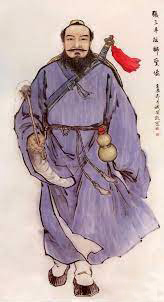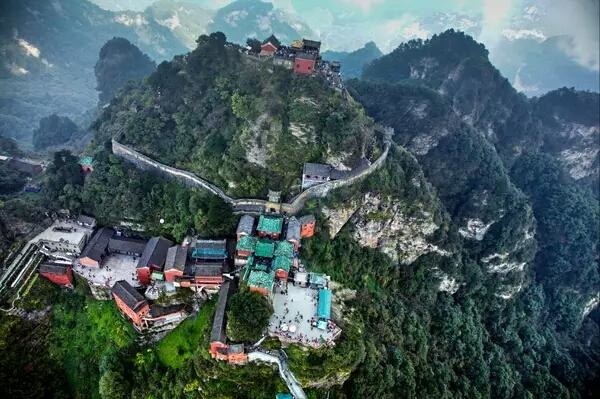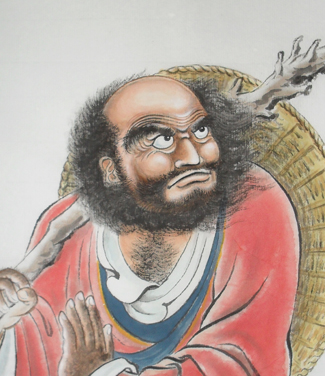Introduction:
Today, Chinese martial arts are usually divided between external styles (外家 wàijiā) and internal styles (內家 nèijiā), a classification that alludes to the degree of expression of internal energy (qì 氣) as opposed to muscle strength.
In fact, it has been the styles that call themselves internal that have made this definition of themselves as opposed to other styles that they describe as external. However, this division is not accepted by all practitioners and, if we contemplate how these concepts originated, we can realize that the classification has little practical basis.
The epitaph to Wang Zhengnan:
The first extant written mention of this distinction of internal and external styles comes from the epitaph to Wáng Zhēngnán 王征南 (王征南墓志銘 Wáng Zhēngnán mùzhìmíng), a martial arts master who lived between 1617 and 1669. This epitaph was written in 1669 by Huáng Zōngxī 黄宗羲, whose son was a pupil of Wáng.
In that text, Huáng designates the martial arts of Shàolín 少林 as "external", saying that their moves are offensive and create opportunities for the opponent to exploit, and speaks of an "internal" school that overcomes the movement with stillness, repelling the attacker easily and effortlessly.
In the epitaph, Huáng attributes the creation of this school to Zhāng Sānfēng 張三丰, a Taoist alchemist from the Wǔdāng 武當 mountains, whom he places in the Sòng 宋 dynasty, and to whom the warrior god Zhēnwǔ 真武 would have transmitted the art of fighting in a dream.

Illustration of Zhāng Sānfēng 張三丰.
Zōngxī's son, Huáng Bǎijiā 黃柏嘉, who, as we have said, studied with Wáng, also left an account of the origins of his mentor's martial arts. In it, he also attributes the origin of the internal school to Zhāng Sānfēng, who he says mastered the arts of Shàolín and reversed its principles to create the Internal School. In addition, he assures that simply learning the rudiments of this art is enough to surpass Shàolín1.
Thus, by the hand of these two authors, the Shàolín-Buddhist-external versus Wǔdāng-Taoist-internal division is configured, which constitutes a new dichotomous paradigm of which there is no record until that moment, but which would be established in the popular imagination among martial arts circles.
Although it is possible that these authors were recording for the first time an already existing distinction, it is more likely that their writings intended to attribute a legendary origin to a new way of understanding martial arts. But perhaps there was something else in all of this. To understand it, we must examine the historical context.

Wǔdāng 武當 temples.
A bit of historical context:
In 1644 the Míng 明 dynasty fell and the new Qīng 清 dynasty was established. This new dynasty was of Manchu origin and, therefore, foreign. Although the Qīng did not generate as much anti-Manchu sentiment as the nationalist discourses of the late nineteenth and early twentieth centuries have led us to believe2, it is true that some officers and scholars maintained their loyalty to the Míng and refused to serve the new government.
Buddhism, despite having arrived in China from India more than a thousand years ago, was still considered a foreign religion. Faced with the repression and control that, in order to avoid rebellions, the new Manchu government exercised over the population, it happened that everything foreign, including Buddhism, began to associate with the Manchus in the popular imagination. Instead, Taoism, a native and authentically Chinese religion, presented itself as the natural counterpart to foreign Buddhism3.
But let's go back to Huáng Zōngxī, author of the epitaph to Wáng Zhēngnán. Huáng had served the deposed Míng dynasty and, after its fall, continued the struggle with some resistance groups, until, in 1649, he abandoned the fight and retired to lead a life of study, refusing to serve the Manchus.
Martial arts historian Meir Shahar considers the Huángs' account, erecting Zhāng Sānfēng as the founder of the internal school, to be a political statement. Both Zhāng Sānfēng and Wǔdāng have a close relationship with the Míng dynasty, as the monasteries of Wǔdāng acted as shrines of the royal family, taoist priests prayed there for the longevity of the dynasty, and the miracles of Zhāng Sānfēng were, in popular imagery, linked to the glory of the dynasty. Shahar also agrees with Douglas Wile that the Huáng were trying to symbolically express their rejection of the Manchus' foreign aggression4.
It is important to note that, in the writings of the Huáng, it is not clearly explained what the internal school was or how it differed from the martial arts practiced in Shàolín.

Lǔ Shènglì 魯勝利 (who writes today), when he speaks in his book Combat Techniques of Taiji, Xingyi, and Bagua: Principles and Practices of Internal Martial Arts about the differences between the internal and external schools, the first one he mentions is that the external school is Buddhist and the internal is Taoist, which does not speak of their martial practice. Then he does refer to the principles, and says that the objective of the external school is to increase natural abilities, while that of the internal school is to change or modify them; but later acknowledges that at high levels, the external school also seeks to "change", and that both practices overlap and interrelate, and concludes that the difference is that both choose different training methods to achieve the same goal. He also warns us that it is a mistake to think that wàijiā practitioners only practice external skills and those of nèijiā only internal5.
We see then that the difference, in terms of practice, is unclear, even today, and if we saw in combat two practitioners of both schools, it would be at least very difficult to differentiate them, since the "internal" power only manifests itself externally.
But, going back to the origins of these concepts, for non-Buddhist Míng loyalists, Shàolín and Buddhism became equivalents of the foreign and, by extension, of the Manchu regime (even though, for Qīng rulers, Shàolín was a place suspected of harboring rebels loyal to Míng). Instead, China's power was internal and hidden, but superior. In this way, the account of the origin of internal martial arts is configured as a discourse on identity and political loyalties, rather than in a description of the martial practice itself6.
Consequences of this paradigm:
This fictitious account of the origin of the internal school gained credibility with the passage of time, along with the dichotomy it proposed, which was in accordance with the ideas already existing in the Taoist tradition that the deep and mysterious was superior to the superficial and vulgar.
Many styles that emerged, such as the Tàijíquán 太極拳, adopted this emphasis on internal practice. However, the martial arts practitioners of Shàolín did not necessarily willingly accept the place assigned to them as an "external school".
Internal martial arts or internal styles:
Qīng dynasty records mention countless styles of martial arts and, despite everything, we can assume that there were many more throughout the length and breadth of China; hundreds or maybe thousands. Most of them have disappeared today, or have been assimilated or classified under the name of some of the main or most practiced styles.
Under the influence of the new discourse on internal styles, some new styles appeared such as Xíng Yì Quán 形意拳, Tàijíquán or Bāguà Zhǎng 八卦掌 which, today, are widely practiced. Most of these styles can be dated to the eighteenth century, and their claims of older origins do not hold up.
Internal styles gained importance throughout the nineteenth century, simultaneously with the development of modern weaponry. As Peter Lorge points out, these styles were appropriate for a world of industrial warfare, where the martial artist had ceased to be a proper combatant in need of defending his life and property from bandits, to become an educated urban worker in need of gentle exercise7.
Despite these circumstances, these styles maintained and, in most cases, still mantain their martial orientation, although today it is getting lost.
Moreover, the view of Chinese martial arts was strongly influenced by contact with the West. The opium wars and defeats suffered at the hands of the West, blamed on the Manchus, left a bitter taste and a damaged image of China to the rest of the world. It was clear that China had to modernize if it did not want to lag behind the West, but it was not so clear to what extent this modernization could be carried out without suffering a "Westernization"; that is, to what extent China should assume the values and customs of the West to the detriment of its own culture.
All this uncertainty and the mixed feelings that were raised left their mark on the vision of martial arts. The strength of Westerners, both in the physical bodies of individuals and in the military power of states, was seen as mere "external" power, inferior to the "internal" strength of the Chinese nation, which nevertheless lay underground and was not apparent.
In 1928, the government of the Republic of China (中華民國 Zhōnghuá Mínguó) established the National Academy of Martial Arts (中央國術館 Zhōng yāng guóshù guǎn). This entity established two schools of martial arts within it: Shàolín and Wǔdāng, thus confirming the dichotomy created in the epitaph to Wáng Zhēngnán three centuries ago. This division gave rise to hostilities within the academy itself, which even reached physical confrontation, so that a short time later the internal structure of the academy was modified by eliminating both departments.
Until 1949, the practice of internal styles remained martial, teaching the combative applications of these arts. But with the coming to power of the Communist Party and the establishment of the People's Republic (中華人民共和國 Zhōnghuá Rénmín Gònghéguó), the methods of combative training were eliminated, transforming these practices into gymnastic and self-realization exercises8.
Influence of the Yìjīnjīng:
The Yìjīnjīng 易筋經 (Muscle/Tendon Change Classic) is a text that deals with a series of principles of "internal" practice that seek to transform the way the body works, with the idea of preparing it to transform the mind and achieve enlightenment. Although it is believed that it was written at the end of the Míng dynasty (17th century), the earliest extant copy of this text dates from the 19th century.
This text had a great impact on martial arts, and was incorporated into the practice of all schools. Internal systems integrated the principles of Yìjīnjīng practice. Shàolín also incorporated them, associating their authorship, of course, with Bodhidharma (Dámó 達摩), and thus claiming a lineage of internal practice.
Later systems were already developed by fully incorporating the principles of Yìjīnjīng. The text states that muscle is not to be built directly but through the action of qì or internal energy, until it acquires the quality of resembling tendons.

Bodhidharma, or Dámó 達摩.
Perhaps the most noticeable difference between the internal and external schools is the emphasis on internal energy that the former makes, rather than emphasising bone structure and mechanical alignment. However, today both schools have already incorporated this terminology, this discourse on internal energy, especially through the inclusion of Qìgōng 氣功 exercises in their training systems.
Conclusion:
We have seen, through the study of the epitaph to Wáng Zhēngnán and the historical and social context that surrounds it, that the division between internal and external schools is born more from an ideological discourse than from an analysis of martial practice.
There will always be those who feel uncomfortable with this demystification of the facts. It is not our intention to devalue anything. On the contrary, we believe that the historical examination and deconstruction of the foundational myths in martial arts should not influence the value of these arts. The meaning of martial arts, especially today when they are no longer used in real combat, lies in the value that each practitioner gives it, depending on what the art itself and its practice bring to him or her.
This value can vary, from being a self-defense mechanism, a way to exercise the body and maintain health, a form of self-realization or even a mere hobby or a simple source of fun. And we believe that if this assessment is made based on what art contributes to the practitioner, it will be, in effect, independent of any fictional or legendary narrative, however heroic it may be.
Notes:
1. This myth spread widely later, but has no historical basis. We will talk about the myth of Zhāng Sānfēng on another occasion.
2. As we have shown on other occasions, the new dynasty did not generate such discontent in its beginnings, especially in northern China, where coexistence with nomads was more common. It is true that in southern China, where there had not been so much contact with the nomadic peoples of the north, there was more hostility. However, widespread anti-Manchu sentiment was a product of the historical and social context of late Qīng.
3. Chinese Martial Arts: From Antiquity to the Twenty-First Century, Peter Lorge. Cambridge University Press, 2012. p. 192.
4. The Shaolin Monastery: History, Religion, and the Chinese Martial Arts, Meir Shahar University of Hawaii Press, 2008. p. 177.
5. Combat Techniques of Taiji, Xingyi, and Bagua: Principles and Practices of Internal Martial Arts, Lu Shengli, Blue Snake Books, 2006. p. 9 and 11.
6. Chinese Martial Arts: From Antiquity to the Twenty-First Century, Peter Lorge. Cambridge University Press, 2012. p. 193-195.
7. Chinese Martial Arts: From Antiquity to the Twenty-First Century, Peter Lorge. Cambridge University Press, 2012. p. 206.
8. Breve Historia del Kung Fu, William Acevedo, Mei Cheung, Carlos Gutiérrez García. Ediciones Nowtilus, 2010. p. 86.
